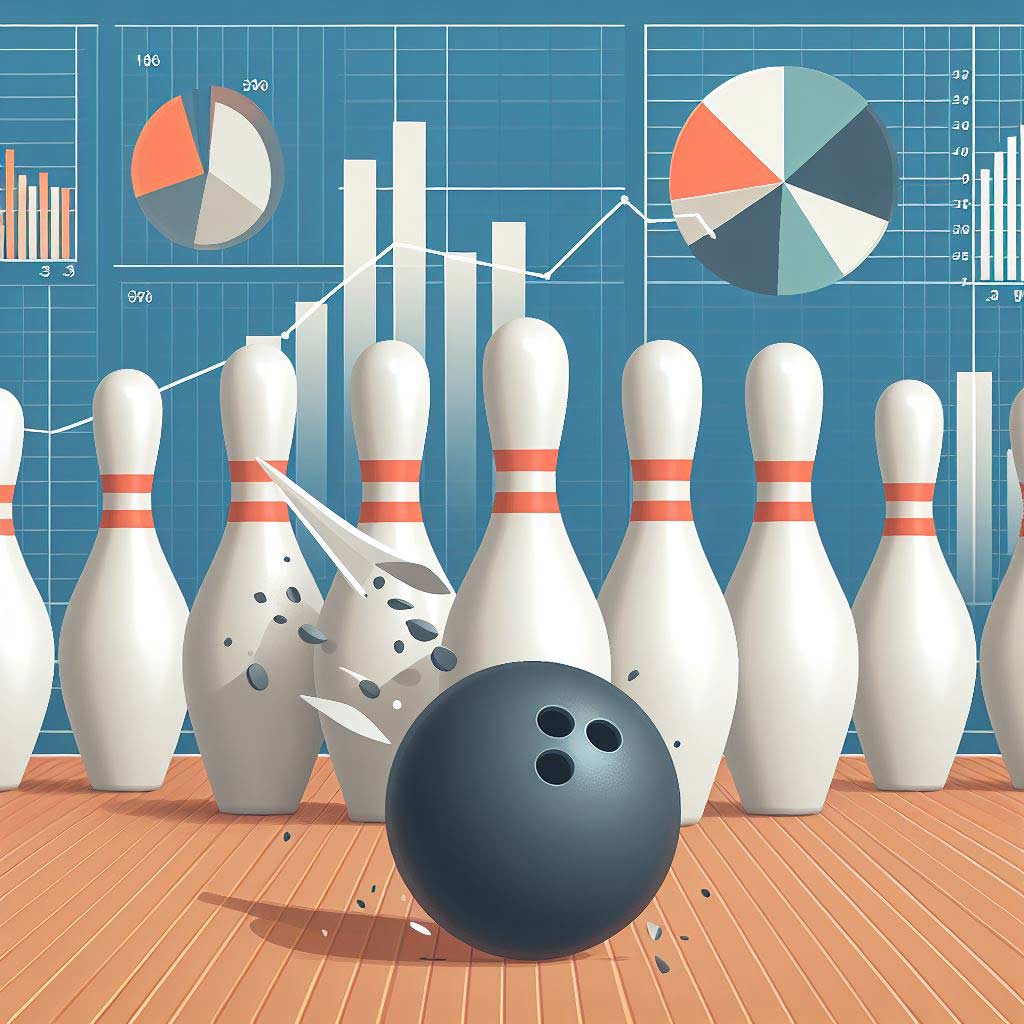Bowling is one of America’s most beloved pastimes. According to the United States Bowling Congress, over 69 million people went bowling in 2018, resulting in over $1 billion in revenue for bowling centers across the country.
With bowling remaining a popular recreational and competitive sport, many entrepreneurs and investors are interested in building new bowling facilities to get in on the action. However, successfully opening and operating a bowling alley requires significant upfront and ongoing investments.
Constructing just a single regulation bowling lane and keeping it in working order can easily cost $150,000 or more. Developing a more substantial bowling center with several lanes, equipment, and amenities will require expenditures in the millions.
This article provides an in-depth look at the major costs involved in building and maintaining bowling lanes and can help you gauge the investment needed to own a bowling facility.
Costs to Build a New Bowling Lane
The bulk of expenditure for a new bowling lane will come from upfront construction and equipment costs. Just obtaining the specialized materials and machinery needed to assemble a functioning bowling lane space can run $100,000 or more.
Here are some of the key upfront costs involved:
Lane Construction
The bowling lane itself is made of several layers of complex materials and requires specialized construction techniques. The lane has an underlayment base made of joists covered in pine or other hardwood.
On top of this sits the actual bowling surface made of narrow maple wood boards running the length of the lane. High-quality maple lumber costs $8 to $15 per square foot. The lane is also heavily lacquered for protection and coated with oil/urethane for the proper ball roll.
A professional lane installation company is needed for properly grading and sanding the woods, nailing the boards, precision oiling/coating, and more. Overall lane construction, including materials and professional labor, costs $15,000 to $30,000 for a single lane.
Pinsetter Machine
The mechanical pinsetter machine automatically clears knocked-over pins and resets them after each bowl. Advanced computerized pinsetters cost between $10,000 to $30,000.
Installing the bulky equipment also necessitates professional electrical and construction work to integrate it with the lane’s back-end systems.
Scoring System
A computer scoring console is another integral piece of technology for recording scores and stats. Advanced scoring systems start at around $10,000. They must be networked properly with lane sensors and the pinsetter.
Additional Bowling Equipment
The bowling lane will need balls of different weights, bowling shoes in every size, ball racks, seating, and more. Outfitting a lane with proper bowling equipment can cost $5,000 or more upfront.
Architect and Contractor Fees
Most bowling lane projects employ an architect for the designs and a general contractor to oversee construction. Their professional fees often add up to 10% or more of total construction costs.
Permits and Site Preparation
Depending on location, extensive permits for plumbing, electrical, construction, occupancy and more may be required. Permit costs depend on the project scale. Prepping the physical site for construction also incurs costs like debris removal.
In total, building a regulation, 60-foot-long bowling lane with state-of-the-art lane materials, machines, and scoring can cost $100,000 to $150,000 or more per lane. Developing a modern bowling alley facility with food/drink areas, restrooms, parking, and additional amenities further drives up the total project costs into the millions.
Ongoing Operating Costs
The expenses don’t stop once the bowling center is open for business. Owners face significant recurring operating costs and upkeep requirements to keep the bowling lanes functioning properly.
Here are some of the ongoing expenses involved with operating a bowling lane:
Lane Resurfacing
To maintain proper ball roll and avoid damage, bowling lanes need regular resurfacing. This involves sanding down the top boards and reapplying protective coatings. Professional resurfacing costs $400 to $1,000 per lane annually.
Machine Maintenance and Repairs
The mechanized pinsetters, ball returns, and scoring systems require regular service, maintenance, and eventual repairs due to constant wear and tear. A pinsetter mechanic should inspect machines monthly. Average annual costs for parts/service can reach $5,000 per lane.
Replacing Rental Equipment
The bowling balls, shoes, and other rental equipment need replacing every few years due to damage and wear. For a busy bowling alley, this can cost tens of thousands of dollars annually.
Staffing Expenses
A bowling center needs desk staff, short-order cooks, janitorial staff, mechanics, etc. Total staffing costs including wages, benefits, and payroll taxes can easily exceed $200,000 a year even for a small operation.
Utilities and Facility Costs
Electricity, gas, water, insurance, telecoms, property taxes, and other expenses related to running the bowling facility space will run thousands monthly.
Marketing and Promotions
Radio/print ads, digital promotions, league sponsorships, and similar outreach is needed to attract bowling leagues and casual bowlers. Marketing can cost $50,000 a year or more.
Considering all the recurring expenses involved with staffing, upkeep, utilities, and promotion, the total operating costs for a 4 to 6 lane bowling facility likely exceed $300,000 annually. Expenses scale up significantly for larger bowling centers.
Factors That Influence Bowling Lane Costs
When budgeting the total cost to build and operate a bowling lane, several factors affect expenditures:
Location
Construction and operation costs vary considerably by region. Urban zones with higher property values and wages require bigger investments compared to rural spots.
The scale of the Facility
A single lane for retail customers has lower costs than a large bowling center with a lounge, arcade, etc. But a bigger facility brings in more revenue potential.
New Construction vs Renovation
Converting an existing retail space avoids certain costs associated with building a structure from scratch. But renovations introduce other complexities.
Upgrades and Amenities
Basic lanes catering to casual bowlers need less investment than deluxe centers designed for bowling leagues and tournaments. High-end upgrades drive up costs considerably.
In the end, the total expenditures involved come down to the specific business model, locations, scale, amenities selected, and more. But in general, preparing even a single regulation bowling lane for customers requires an upfront investment of at least $100,000 when accounting for professional construction, machines, and more.
Operating costs can easily exceed $50,000 annually per lane when factoring in staff, maintenance, utilities, and promotion. These costs only multiply for bigger bowling centers with extra features and more lanes.
The Financial Viability of a Bowling Lane
Given the substantial figures outlined above, opening a bowling lane requires considerable capital and financial planning. Constructing a multi-lane bowling alley facility demands investments in the millions.
However, a thoughtfully designed bowling center in the right location can produce over a million dollars in annual revenues through lane rentals, equipment rentals, food/beverage sales, and more.
Savvy owners optimize the customer experience, league and event offerings, promotions, and operational efficiency to maximize profitability over time.
But bowling centers also face risks like declining league participation, competition from other entertainment options, seasonal slow periods, and rising operations costs that can squeeze margins over the long term.
Careful planning based on realistic expense and revenue projections is key to determining if a bowling lane business will be profitable or not. Owners must also have access to sufficient capital to withstand the considerable upfront and ongoing costs involved.
The Bottom Line
Building and operating bowling lanes demands serious financial commitments and business acumen. But bowling remains a classic American pastime that loyal enthusiasts continue to enjoy.
With mindful planning, top-notch equipment, and customer service, a thoughtfully designed bowling facility in the right market can roll in profits for many years by meeting the needs of casual bowlers and league fanatics alike.
Just be sure to enter the bowling lane business with eyes wide open to the significant capital requirements involved. With prudent financial planning and efficient operations, your bowling venture can score strikes for many years to come.
Frequently Asked Questions
Are bowling alleys profitable?
Bowling alleys can be profitable if well-located, efficiently operated, and effectively marketed to leagues and events. But significant upfront and ongoing costs must be managed.
Is bowling expensive for 2 people?
Bowling for 2 people costs $15-$30 per game, $3-$8 per rental shoe, plus food/drinks. So a night out bowling for 2 can run $60-$100.
How do I start a bowling alley business?
Starting a bowling alley involves extensive planning, finding a suitable property, securing multi-million dollar financing, hiring contractors, purchasing equipment, and handling licensing, permits, marketing, hiring, and operations.
How big is the Brunswick Bowling Lane?
The regulation Brunswick bowling lane size is 60 feet from the foul line to the head pin. The lane is 42 inches wide and bordered by gutters that are 15 inches wide.
Are bowling alleys good investments?
Bowling alleys can provide stable returns but require substantial capital investments and hands-on management. Success depends on location, operations, leagues/events, and controlling costs.
How much money can you make bowling?
For top professional bowlers, annual earnings from tournaments and endorsements can exceed $200,000. But most recreational and amateur players do not make significant money bowling.
Why is going bowling so expensive?
Bowling costs are high due to land/construction costs, specialized equipment, maintenance, staffing requirements, and more. But bowling still provides an affordable night out.
How many people can bowl in one lane?
Typically 4-6 people can comfortably bowl in a single lane. More is possible but will slow down the game with switching players each frame.
How long do 2 games of bowling take for 2 people?
At a typical pace with no wait, 2 people can complete 2 full games of 10 frames in about 1 hour. Allow more time for shoe rentals and breaks.





